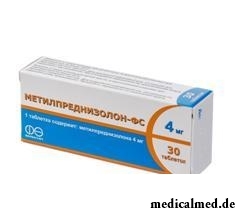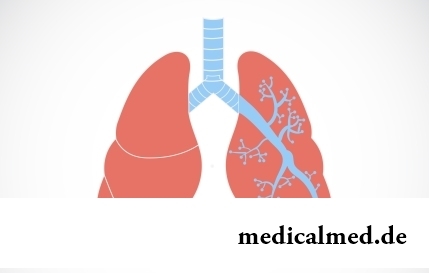





Metilprednizolon-FS
Application instruction:
 Metilprednizolon-FS – drug with antiinflammatory, immunodepressive and antiallergenic effect.
Metilprednizolon-FS – drug with antiinflammatory, immunodepressive and antiallergenic effect.
Form of release and structure
Metilprednizolon-FS release in the form of tablets: white or almost white, ploskotsilindrichesky, round, with a notch in the form of a cross (on 10 pieces in blister strip packagings, on 3 packagings in a cardboard pack).
Is a part of 1 tablet:
- Active agent: Methylprednisolonum – 4 or 8 mg;
- Auxiliary components: monohydrate of lactose, corn/potato starch, krakhmalglikolit sodium (type A), magnesium stearate, anhydrous colloid silicon dioxide.
Indications to use
- Endocrine diseases: primary and secondary insufficiency of a bast layer of adrenal glands (in this case drugs of the first row are the cortisone or a hydrocortisone; if necessary synthetic analogs can be applied along with mineralokortikoida that is especially important for treatment of children), not purulent thyroiditis, an inborn adrenal struma, a hypercalcemia at malignant tumors;
- Rheumatic diseases (as additional therapy for short-term use at an aggravation of process or for the purpose of removal of the patient from an acute state): the ankylosing spondylitis, psoriasis and a pseudorheumatism, including a juvenile pseudorheumatism (the maintenance therapy low doses in some cases can be required), tendosinovit a subacute and acute bursitis, acute gouty arthritis, acute nonspecific, a posttraumatic osteoarthritis, a synovitis at an osteoarthritis, an epicondylitis;
- Collagenoses (during an aggravation or as a maintenance therapy): a system lupus erythematosus, a system dermatomyositis (polymiositis), an acute rheumatic carditis, a rheumatic polimialgiya at giant-cell arteritis;
- Skin diseases: violent herpetiform dermatitis, heavy seborrheal dermatitis, pemphigus, heavy multiformny erythema (Stephens-Johnson's syndrome), exfoliative dermatitis, fungoidny mycosis, severe forms of psoriasis;
- Diseases of eyes (heavy acute, chronic inflammatory and allergic processes with damage of eyes and the adnexal device): an inflammation of front department of an eye, allergic regional helcomas, the damage of eyes caused by Herpes zoster, a diffusion back uveitis and a choroiditis, a sympathetic ophthalmia, an optic neuritis, a keratitis, allergic conjunctivitis, a chorioretinitis, an iridocyclitis and an iritis;
- Allergic diseases: bronchial asthma, dermatitis (atopic, contact), a medicamentous allergy, a serum disease, year-round or seasonal allergic rhinitis (at inefficiency of standard therapy);
- Diseases of a respiratory organs: a symptomatic sarcoidosis, Leffler's syndrome (resistant to therapy by other methods), a berylliosis, the fulminantny or disseminated pulmonary tuberculosis (along with carrying out the corresponding antitubercular chemotherapy), an aspiration pneumonitis;
- Hematologic diseases: the acquired (autoimmune) hemolitic anemia, secondary thrombocytopenia at adults, an idiopathic Werlhof's disease at adults, an eritroblastopeniya (erythrocyte anemia), inborn (erythroidal) hypoplastic anemia;
- Diseases of the alimentary system: ulcer colitis, a disease Krone (for removal of the patient from a critical state);
- Diseases of a nervous system: multiple sclerosis (at an aggravation), the wet brain caused by a brain tumor;
- Oncological diseases: lymphoma and leukoses at adults, an acute leukosis at children (as palliative therapy);
- Edematous syndrome: a proteinuria at a nephrotic syndrome without uraemia, idiopathic type or connected with a system lupus erythematosus (for induction of a diuresis or therapy);
- Diseases of other bodies and systems: tubercular meningitis with the subarachnoidal block or in the presence of threat of development of the block (along with carrying out the corresponding antitubercular chemotherapy), a trichinosis with damage of a myocardium or a nervous system.
Contraindications
Absolute:
- Acute and persistent bacterial or viral infections at an insufficient antibiotiko-and chemotherapy;
- System fungal infections;
- The period of 6 weeks to and 2 weeks after preventive inoculations;
- Introduction of live or live attenuirovanny vaccines (at purpose of immunosuppressive doses of Metilprednizolona-FS);
- Hypersensitivity to drug components in the anamnesis.
Relative (Metilprednizolon-FS should be taken with caution at the following diseases / states):
- Arterial hypertension;
- Congestive heart failure;
- Diabetes mellitus or instructions on a disease in the family anamnesis;
- Pancreatitis;
- Diseases of a digestive tract (a local ileitis, a round ulcer, ulcer colitis or other inflammatory diseases of a digestive tract or a diverticulitis with the increased risk of perforation and bleeding);
- Herpes of eyes (because of possible perforation of a cornea);
- Glaucoma;
- Hypothyroidism, corticosteroid - the induced myopathy in the anamnesis;
- Liver failure;
- Cirrhosis;
- Renal failure;
- The intestinal anastomosis imposed recently;
- Abscess or other piogenic infections;
- The myocardial infarction postponed recently;
- Epilepsy;
- Blood coagulation disturbances;
- Tendency to development of thrombophlebitis;
- Mental disorders.
Route of administration and dosage
The initial dose of Metilprednizolona-FS for adults is defined by indications. At less serious illnesses there can be sufficient low doses though appointment and higher starting doses in certain cases can be required.
At circadian therapy of Metilprednizolon-FS it is necessary to accept after food, without chewing, washing down with necessary amount of liquid, it is more preferable – after a breakfast. In certain cases, for example, in the presence of morning and night attacks at patients with obturatsionny diseases of lungs, reception of a daily dose in 2 receptions is possible: 2/3 doses in the morning (between 6:00 and 8.00), other part – in the evening (in an interval between 18:00 and 20.00).
As a rule, high daily doses are appointed according to the following indications:
- Multiple sclerosis: 200 mg;
- Wet brain: 200-1000 mg;
- Organ transplantation: to 7 mg/kg.
In the absence of sufficient therapeutic effect it is necessary to cancel drug and to appoint alternative treatment.
After the end of therapy Metilprednizolon-FS it is necessary to cancel gradually.
At achievement of satisfactory result the patient needs to pick up a maintenance dose individually. For this purpose gradually, through certain intervals of time, reduce an initial dose, the smallest effective dose allowing to support the reached effect will not be found yet.
At the changes of a clinical state caused by approach of remission or an exacerbation of a disease, the dose should be adjusted. Also change of the mode of dosing is possible at the stressful situations which are directly not connected with a basic disease (short increase in a dose in certain cases can be required).
Purpose of alternating therapy – the mode of dosing at which the doubled daily dose of Metilprednizolona-FS is appointed every other day, in the morning is also possible. As a rule, such type of therapy is shown at long use of drug for minimizing of some undesirable actions, including oppression of growth at children, a cushingoid condition, a withdrawal, oppression of pituitary and adrenal system.
Side effects
Development of heavy side reactions depends on the accepted dose of Metilprednizolona-FS and duration of therapy. As a rule, disturbances develop at long administration of drug.
During treatment there can be following side effects:
- Cardiovascular system: an embolism, arterial hyper - or hypotension, heart failure at cardiological patients, a rupture of a myocardium in a zone of the postponed myocardial infarction;
- Alimentary system: pancreatitis, dyspepsia, nausea, gastric bleeding, an abdominal pain, abdominal distention, diarrhea, round ulcers with perforation and bleeding, an esophagitis, an ulcer esophagitis, ulcer colitis with possible perforation of a gut, increase in activity of alaninaminotranspherase, aspartate aminotransferase and an alkaline phosphatase (as a rule, is not significant and has reversible character);
- Endocrine system and metabolism: increase in level of calcium in urine, oppression гипоталамо - pituitary and adrenal system, a growth inhibition at children, disturbance of a menstrual cycle, increase in body weight, a cushingoid syndrome, increase in appetite, a hirsutism, reduction of tolerance to carbohydrates, manifestation of a latent diabetes mellitus, increase in need for insulin and peroral glucose-lowering drugs at patients with a diabetes mellitus, negative balance of nitrogen and calcium, disturbance of electrolytic balance and mineral exchange, epidural липоматоз, a hypopotassemia and a gipokaliyemichesky alkalosis, a metabolic acidosis, a delay of liquid and sodium in an organism;
- Nervous system: a brain pseudoneoplasm, increase in intracranial pressure (with a papilledema (benign intracranial hypertensia)), convulsive attacks, amnesia, a headache, dizziness;
- Immune systems: hypersensitivity to drug components (including anaphylactoid and anaphylactic reactions), change of reactions to skin tests;
- Musculoskeletal system: osteoporosis, steroid myopathy, pathological changes, rupture of sinews (especially Achilles sinew), arthralgia, muscular weakness, neyropatichesky arthropathy, osteonecrosis, mialgiya, muscular atrophy, compression spinal fractures;
- Skin: skin atrophy, regeneration delay, dryness and thinning of skin, erythema, emergence of hematomas and atrophic strips of skin (striya), itch, Quincke's disease, rashes, urticaria, teleangiectasia, hyperhidrosis, acne rash, ecchymomas, petechias, Kaposha's sarcoma;
- Blood and lymphatic system: increase in total quantity of leukocytes at reduction of number of eosinophils, lymphocytes and monocytes, increase in coagulability of blood;
- Acoustic organ and balance: вертиго;
- Organ of sight: increase in intraocular pressure, thinning of a sclera and cornea, back subkapsulyarny cataract, glaucoma, exophthalmos, central serous horioretinopatiya;
- Infections and invasions: increase in a susceptibility to viral, bacterial and fungal infections and their weight with masking of signs, a recurrence of latent tuberculosis, activation of latent infections, opportunistic infections;
- Psychiatric disturbances: changes of the personality, a depression, irritability, euphoria, tendency to a suicide, lability of mood, sleeplessness, psychoses, psychological dependence, psychotic frustration and behavior, dementia, sleep disorders, pathological behavior, uneasiness, cognitive dysfunction (including confusion of consciousness and amnesia);
- The general: recovery process disturbance, an indisposition, increased fatigue, a resistant hiccups at use of Metilprednizolona-FS in high doses, a hypoglycemia, a withdrawal (at sharp cancellation).
Special instructions
During therapy it is necessary to consider a possibility of influence of Metilprednizolona-FS on various systems of an organism:
- Cardiovascular system: with risk factors prolonged use of drug in high doses can cause development of additional complications (careful monitoring of a condition of the patient is necessary);
- Digestive tract: reduction of a pain syndrome can complicate carrying out diagnosis of complications of a digestive tract; also therapy of GKS can mask hyper parathyroidism stage of latency, symptoms of a round ulcer, bleeding or perforation without the expressed pain syndrome;
- Immune system: because of a possibility of development of allergic reactions before therapy it is necessary to take necessary measures, in particular in the presence of an allergy to medicines in the anamnesis;
- The raised susceptibility to infections / immunosuppressive effects: because of decrease in resistance to infections there is a risk of development of the consecutive infections caused by bacteria, viruses and fungi, protozoa or helminths of any localization in an organism; frequency of emergence of infectious complications increases at increase in a dose;
- Mental disorders: against the background of reception of Metilprednizolona-FS already existing tendency to psychotic reactions and emotional instability can amplify. Symptoms of potentially heavy mental disorders usually appear for several days or weeks from the moment of an initiation of treatment. As a rule, they pass after a dose decline or cancellation of therapy though purpose of special treatment can sometimes be required;
- Organ of sight: at long therapy the back subkapsulyarny cataract and a nuclear cataract (in particular at children), increase in intraocular pressure or an exophthalmos can develop that can lead to developing of glaucoma with possible damage of an optic nerve. Also the risk of development of the consecutive infections of an eye caused by mushrooms and viruses increases;
- Musculoskeletal system: an acute myopathy (most often develops in the presence of disorders of neuromuscular transfer or at the patients who were at the same time applying anticholinergics); at long therapy in many cases development of osteoporosis was noted (treat factors of its emergence: age of 65 years, frequent changes in the family anamnesis or the anamnesis of the patient, a premenopauzalny amenorrhea, an early menopause (up to 45 years), small body weight);
- Endocrine system: at a diabetes mellitus prolonged use of Metilprednizolona-FS can lead to increase in content of glucose in blood and to an aggravation of symptoms of patients. At sharp cancellation of therapy development of acute insufficiency of epinephral glands is possible that can lead to a lethal outcome therefore drug should be cancelled gradually, for several weeks;
- Others: because of risk of increase in arterial pressure, a delay of water and salts and increase in secretion of potassium at long therapy it is regularly recommended to determine glucose level in urine and in blood, to control arterial pressure, to carry out the analysis a calla on the occult blood, radiological control of a backbone, definition of indicators of sedimentation of erythrocytes. At the combined use with diuretics it is necessary to control electrolytic balance carefully. At use of Metilprednizolona-FS for prevention of a hypopotassemia it is necessary to adhere to the corresponding diet with the limited use of salt and reception of potassium nutritional supplements.
During use of Metilprednizolona-FS there is a risk of development of such side reactions as вертиго, dizziness, fatigue, disturbances from sight, disturbance of mood. In these cases it is not recommended to manage motor transport or to work with other mechanisms the patient.
Medicinal interaction
At simultaneous use of Metilprednizolona-FS with some medicines there can be following effects:
- Rifampinum, Phenytoinum, pyramidon, phenobarbital: decrease in effect of Methylprednisolonum (increase in a dose can be required);
- Isoniazid, grapefruit juice, makrolidny antibiotics (тролеандомицин): increase in level of Methylprednisolonum in a blood plasma that can lead to strengthening of therapeutic and collateral actions;
- Cyclophosphamide, такролимус: induction of hepatic clearance of Methylprednisolonum, increase in risk of development of side effects;
- Peroral contraceptive means: increase in risk of development of atypical immunosuppressive effect;
- Cyclosporine: probability of development of spasms;
- Ritonavir, индинавир: increase in concentration of Metilprednizolona-FS in a blood plasma;
- HIV protease inhibitors: induction of their metabolism because of what their concentration in a blood plasma decreases;
- Aminoglutetimid: an aggravation of the endocrine changes caused by long therapy of Metilprednizolonom-FS;
- Salicylates and other non-steroidal anti-inflammatory drugs: increase in probability of a canker of a mucous membrane of a stomach and risk of development of gastrointestinal bleedings;
- Anticholinergics: increase in probability of development of an acute myopathy;
- Anticoagulants: strengthening or reduction of their action (it is necessary to control a prothrombin time);
- Hypoglycemic drugs: decrease in their efficiency;
- Ftorkhinolona: injury of sinews;
- Immunization: increase in risk of development of viral diseases;
- Somatotropinum: decrease in its effect;
- Cardiac glycosides: strengthening of their action;
- Chloroquinum, Hydroxychloroquinum: increase in risk of development of a cardiomyopathy and myopathy;
- Praziquantel: decrease in its concentration in blood;
- Diuretics, Amphotericinum: increase in probability of emergence of a hypopotassemia.
Terms and storage conditions
To store in the place, unavailable to children, at a temperature up to 25 °C.
Period of validity – 3 years.
Was considered earlier that yawning enriches an organism with oxygen. However this opinion was disproved. Scientists proved that yawning, the person cools a brain and improves its working capacity.

Eyes – one of the most vulnerable areas on a face therefore age changes concern them first of all. Whether it is possible to keep a pier...
Section: Articles about health
A little more than a century ago goat milk was a traditional food stuff of most of Russians. Unfortunately, today on tables of our compatriots it appears extremely seldom. The reason that the use of so useful product practically descended on...
Section: Articles about health
Life does not indulge the modern woman special emotional comfort and carelessness. The fatigue, troubles at work, misunderstanding in a family and various illnesses immediately affect a condition of hair and skin. And there is a wish to look safe and attractive so! Substantially competently picked up diet can improve situation....
Section: Articles about health
Life of the modern child is extremely active and difficult. Information strain which is experienced by the school student and did not dream the pupil...
Section: Articles about health
Obesity is called a disease of 21 centuries, for the last 100 years the number of the people suffering from excess body weight considerably increased. Statistically, on Earth already about 1,5 billion corpulent people, and 500 million from them have extreme degree of completeness, are negative...
Section: Articles about health
Proofs of efficiency of Mildronate at treatment of coronary heart disease with stenocardia can be found in many publications of the end of the twentieth century. Researches were conducted since 1984, including placebo - controlled effects. In total clinical tests of Mildronate were carried out for more than thirty years....
Section: Articles about health
The hysteromyoma is diagnosed more than at a third of women 35 years are more senior. This high-quality new growth, which on early a stage...
Section: Articles about health
Not without reason doctors say that 90% of diseases begin or develop because of misoperation of intestines. Disturbance of its functions is connected with various factors among which the important place belongs to excessive "clutter" of an intestinal path. In an organism скаплив...
Section: Articles about health
They say that to ensure health and longevity of people it is obliged. Really, at competent approach to these questions, minimization of an adverse effect of many factors does not represent a special problem. Practically everyone has an opportunity to play sports, to pick up an optimum operating mode and rest, to adjust healthy food, to refuse addictions. It is more difficult to exclude hit in an organism of harmful substances through a respiratory organs: not all are able to afford to live in the area with хо...
Section: Articles about health
Transfusion of donor blood has almost century history. In spite of the fact that this procedure is quite usual for many people, itself п...
Section: Articles about health
Condition of lips (their morbidity, outward) – one of indicators of health of the person. The peeling, dryness, pallor, and also cracks in corners of a mouth can be not only the cosmetic shortcoming which arose owing to physical damages and weather having sent away...
Section: Articles about health
According to data of World Health Organization, the cataract is diagnosed almost for 7% of the population of Earth. The statistics of incidence is considered not full as at an initial stage the illness, as a rule, does not cause to the person of special inconveniences, and many diseased sees doctors not at once. The cataract is not only one of the most widespread ophthalmologic illnesses, but also the reason of a half of cases of loss of sight....
Section: Articles about health
Some people consider what for medicine of the 21st century of secrets in the field of health of the person almost does not exist. It absolutely not so. Than Bol...
Section: Articles about health
Tick-borne encephalitis – one of the most dangerous viral diseases which causative agents transfer and is given to people by ixodic mites. These are the small blood-sicking insects living in the considerable territory of our country. The person bitten by a tick can catch...
Section: Articles about health
Sugar - the digestible refined product which is not of special value for an organism of the modern person. The use of sugar in food is based rather on the psychological dependence caused by desire to indulge itself with something tasty, and further and the biological, caused need of an organism for glucose as a result of big emissions of insulin in blood. Such circulation of insulin and glucose with continuous increase in portions of sugar is rather offensive and can become the reason for a narusha...
Section: Articles about health
All diseases from nerves – in this joke a big element of truth, are said by doctors. Constant stresses lead body to decrease in protective forces...
Section: Articles about health
The winter swimming in open reservoirs called in our country by "winter swimming" – officially recognized sport and one of the most extreme ways of a hardening of an organism. This occupation has an old story and adherents in many countries. Are annually carried out...
Section: Articles about health
Iodine - one of thirty most important microelements in our organism. The main role of iodine consists in synthesis of thyroid hormones of a thyroid gland - the substances which are responsible for the majority of exchange processes of an organism. It is known that thyroid hormones consist of iodine more than for 65%. The lack of iodine leads to decrease in production of hormones and, as a result, development of a hypothyroidism. The long condition of deficit can become a source of problems of the cardiovascular, bone, digestive SI...
Section: Articles about health
Mushrooms - the surprising inhabitants of our planet having a set of wonderful qualities. Thanks to one of them, a mold mushroom of Penici...
Section: Articles about health
The immunity role in growth of the child is invaluable. The proteins-immunoglobulins produced by immune system preserve the child against the diseases capable − owing to an organism weak still − to serve as a stressful factor, to become the reason of many complications and delays in unless...
Section: Articles about health
Childbirth is the most important event in life of each woman. We are women we give birth to the new little man on this light. Now the tendency to that was outlined, as men want to participate in labor too. But there is a question and whether it is worth allowing the husbands on childbirth?...
Section: Articles about health
Sooner or later hair turn gray at all. Many people try to hide these changes, returning natural color of the hair with the help about...
Section: Articles about health
Practice of use of table salt in the therapeutic purposes contains not one century. Applications which do by means of the fabric impregnated with saline solution are considered especially effective. They possess antibacterial and antiinflammatory эффек...
Section: Articles about health
All are familiar with cold, and practically everyone believes that he has sufficient knowledge and experience that correctly to treat it. In practice most of people makes mistakes in attempts to get rid of rhinitis, and divides numerous delusions it....
Section: Articles about health
The phenomenon of improvement of a condition of the patients at administration of drugs who are not containing active agents, so-called effect of placebo is known...
Section: Articles about health
For the city dweller the fitness is the most convenient sport. It is enough to acquire the subscription to the gym to get access to various apparatuses and an opportunity to train under the leadership of the experienced consultant. Many consider fitness on...
Section: Articles about health
History of mankind contains several tens of epidemics whose emergence was compared by eyewitnesses and historians to doomsday. The most terrible of them claimed the lives of millions of people, having made even the whole people to the person of the earth. What they − the diseases striking terror? Whether it managed to the person to find treatment, or he is still powerless before forces of nature?...
Section: Articles about health
